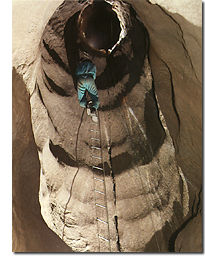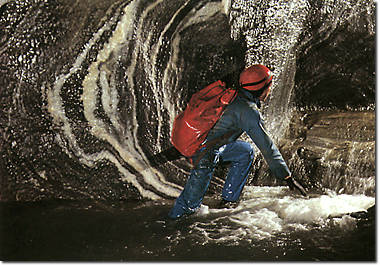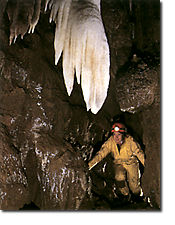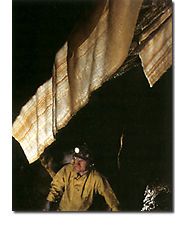 I DROP to my belly in the grit and mud, and slither beneath a fanged curtain of marble into the Dragon's Teeth Room. The small chamber lies deep underground in a Sierran canyon east of Fresno, California. When I regain my feet, Carol Vesely directs the conical glow of her head lamp toward the all but invisible aperture through which I just passed. "Take a good look at that," she says, "because on your way out you want to remember it." There are nine outlets leading in all directions from the chamber, several of them clearly visible. But this cave, worn out of the marble by water rushing or trickling through its fissures for millennia, has hardly been designed for human use, and the appropriate exits are not convenient, intuitive, or marked. The low, emphatically uninviting feature that gives this room its name does not even resemble an egress: the navigable passage immediately behind the teeth rises steeply for some feet and appears to be a continuation of the chamber's irregular wall. But it is the only passage from this region of the cave that
leads to the sun. I nod, forewarned, and commit the lithic maw to confident
memory.
I DROP to my belly in the grit and mud, and slither beneath a fanged curtain of marble into the Dragon's Teeth Room. The small chamber lies deep underground in a Sierran canyon east of Fresno, California. When I regain my feet, Carol Vesely directs the conical glow of her head lamp toward the all but invisible aperture through which I just passed. "Take a good look at that," she says, "because on your way out you want to remember it." There are nine outlets leading in all directions from the chamber, several of them clearly visible. But this cave, worn out of the marble by water rushing or trickling through its fissures for millennia, has hardly been designed for human use, and the appropriate exits are not convenient, intuitive, or marked. The low, emphatically uninviting feature that gives this room its name does not even resemble an egress: the navigable passage immediately behind the teeth rises steeply for some feet and appears to be a continuation of the chamber's irregular wall. But it is the only passage from this region of the cave that
leads to the sun. I nod, forewarned, and commit the lithic maw to confident
memory.
Vesely, now forty-one, is "the epitome of the gung-ho woman caver in this country," according to the caving historian Ernst Kastning. "She is right there with the best of the men. And she can outdo a lot of them." In twenty-one years Vesely has made a thousand trips into 350 caves in fifteen
countries, including the United States, Mexico, Austria, China, Papua New
Guinea, and Belize. The chair of the National Speleological Society's Survey and Cartography Section, she has surveyed more than seventy-five miles
of underground passage worldwide. In 1986, with her husband, Bill Farr, Vesely discovered Cueva Cheve, in Mexico. Currently known to be 5.7 miles long and 4,547 feet deep, Cheve is the second-deepest known cave in the Western Hemisphere.
At five feet four and 120 pounds, Vesely is slight and small-boned. Her blonde hair, worn long in a ponytail, is graying. She wears broad-lensed eye-glasses and no makeup, and might strike one in passing as a schoolteacher or an academic. In fact, until recently she worked as a substitute teacher near her home in Monrovia, California, and she is her dissertation shy of a Ph.D. in cognitive developmental psychology from the University of California at Santa Barbara. In addition to holding two part-time jobs, Vesely now works as a full-time mother. At the moment, her two-year-old son, Brian, awaits her on the surface, in the company of his father, at a rebuilt miners' cabin minutes from the cave's north entrance. A laser designer, electrical engineer, and computer
scientist, Bill Farr is a speleophile with an extreme if not morbid fondness
for cave diving, or scuba diving in subterranean waters.
One of the first things one learns from cavers is that they are categorically opposed to the term "spelunker." A spelunker, I gather, is anyone who wanders ill-advisedly into a cave without adequate equipment or training. Not even young Brian Farr is a spelunker -- he has already accompanied his parents into fifteen caves.
I have visited a number of commercial and wild or semi-wild caves, in places
from Oregon and South Dakota to Crete. Some of these were neon-lit and
miserable, advertised on billboards along American highways; others were dark and undeveloped and beautiful. In one Colorado cave, I stumbled on a small subterranean lake edged by a perfect crescent of sand. Virgin passage, however (terrain unseen by man or woman), is something I have never encountered. When the opportunity arose to join Vesely and sixteen other veteran cavers for a weekend of exploration and survey at Lilburn, the longest known cave in California, I thought it might be my chance. I gradually set my hopes, in fact, on discovering a chamber -- however small -- and naming it for my infant daughter, Julia.

A caver explores Lilburn cave's Enchanted River
Lilburn has nearly sixteen miles of known passage and much that remains
unexplored. The cavers have split up into several teams, each planning to
explore or survey a different section of the cave. My group includes Vesely,Roger Mortimer, and Art Fortini. Mortimer, thirty-three, is a physician in family practice and an AIDS consultant from Fresno. Fortini is a thirty-five-year-old chemical engineer and a mountaineer and alpine Search and Rescue volunteer living in Pasadena. Both men have been caving since 1984. At five feet six and 130 pounds, Fortini is well proportioned for subterranean travel. Stripped to his long johns, he looks very nearly capable of entering a house through the cat door. Our group is also accompanied temporarily by Marianne Russo, an archaeologist, and Bill Frantz, a computer-security expert. Russo, forty-five, has fifteen years of caving experience. Frantz, fifty-three, has been caving for nearly thirty years.
A caver's standard equipment includes boots, durable and preferably
waterproof coveralls and gloves, a helmet, an electric or carbide head lamp,
spare batteries or carbide, no fewer than two reserve light sources, and a
small pack containing food, water, a first-aid kit, and extra layers of clothing. Many cavers also wear one or more layers of synthetic long
underwear, kneepads, and, in a cold cave like Lilburn, a hat or a balaclava. In warmer caves (the temperature in some caves in Mexico hovers at more than
100°) cavers may strip to their shorts or skin. Not only is this more comfortable, but it decreases the cavers' cumulative, inevitably destructive impact on delicate surfaces and formations. For sections involving climbing or rappelling, cavers carry harnesses, caving rope, and climbing hardware. Cave divers must haul scuba gear from the mouth of the cave to the dive site -- commonly a sump, or submerged passage.
WE aim to investigate several leads in an area of Lilburn known as the Schreiber Complex. One of the leads is marked cryptically on the map "Hard climb -- Roger knows the way." Not our Roger; the note was scrawled several years ago by an unknown hand.
Frantz is particularly familiar with this area of the cave and will guide us to a turnoff close to the climbing lead. We follow him wordlessly in single file, ducking and crawling and creeping, scooting and sliding on our heels and backsides, climbing and crabbing over boulders as big as cottages. The marble is speckled or striped or swirled in combinations of black and white and blue-gray. The patterns are wild and artful, apparently random like the forms and hollows themselves, which endlessly constrict and broaden, arcing and twisting, rising and climbing and dropping away into darkness. The cave is cool at 46°, and damp. The stone sweats; water pools in low places. The nether reaches of the cave have flooded periodically, and a sediment of granitic sand covers parts of the passage floor. In places the marble is concealed, spackled by the ebbing waters with a coat of fine sand that falls away under a glove.
We are traveling unroped, exposing ourselves to falls, as Mortimer later
observes, to a degree that we might not tolerate under the all-revealing light of day. In the selective gleam of my head lamp a yawning ravine to the
right -- its shadowed depths chaotic with cracked blocks, lunging tusks, and broad, gently curving sails of marble -- is less intimidating the moment I direct my gaze to the narrow, sandy shoulder of marble along its edge. Abandoned to the darkness, such features cease in a sense to exist.
My plastic-coated gloves become slick with mud. Ooze penetrates the cuffs, and a grainy fluid trickles down into the fingertips.

A stalactite known as
The Canopy
We soon arrive at the Great White Pillar, a twenty-foot column of gleaming ivory calcite, or flowstone, in a chamber fifteen minutes from the cave's south entrance. Frantz, Vesely, and others have made frequent trips into Lilburn to clean and repair such formations, muddied or damaged over the years by accident or intent. The need for such active conservation has increased apace with rising traffic through Lilburn and other caves worldwide. We pause to admire the column and then part ways with Frantz and Russo. My group of four continues toward the Schreiber Complex, eager to investigate the climbing lead described on the map. We discover that the climb has been choked by a cave-in, called "breakdown" by cavers. This is not uncommon; breakdown can occur during any stage of a cave's evolution. I contemplate the densely packed jumble of mud and marble chunks, and reflect that the trick is to make sure you're not around when it happens. While Vesely studies the map, Mortimer and Fortini make short reconnaissance trips into neighboring passages. Vesely is unsure whether a narrow chimney nearby has been explored, and I clamber up it, shinnying with elbows and knees. It is a slender corkscrew of slippery mud, marble, and rippled orange flowstone, and it ends shortly in a tight passage clogged with sand.
We break for a meal at the union of a deep crack -- as black as pitch and wide enough to admit a body -- and a sandy crawl way. There is no room for us all in the sand, so I seat myself comfortably on a large chockstone wedged in the fissure. I dine on bagels and energy bars, but Fortini has been more resourceful. He assembles a makeshift pizza from ingredients kept warm against his ribs in his cave pack.
After lunch my fellow cavers produce a compass, an inclinometer, and
a measuring tape to survey an unmapped section of known passage. Unlike
traveling through the cave, which is steady and athletic, our surveying is slow and painstaking work. Minutes later, twisted on my back in a tight crawl space to read a measurement, I realize just how wet and cold and mud-spattered I am. Surveying gives you time to think, I discover -- and when you're wedged in a slot underground, time to think is not always a good thing.
"I ask myself if I would do this voluntarily," I say aloud. "The surveying, that is. And I suspect I wouldn't."
Vesely, who is sketching the passage behind me, snickers from the wobbling gloom
The passage zigs and zags and zigs again, and soon I have an opportunity to enjoy another of the cave surveyor's myriad pleasures. I am standing in eight inches of sucking mud, and I cannot read the tape because it, too, is mud-covered. I swipe it with a muddy thumb, back and forth, with no result. "Lick it," Fortini advises. The mud is cool, grainy, and absolutely without flavor. But the tape is now legible.
After more than an hour we reconnect to a previously surveyed passage, stow the instruments, and meander on. We come upon the rocky shores of a small lake. The water is still, shallow, and perfectly clear. We make a climb that skirts the lake, and at one point I drop left and down into a three-by-three-foot windowed chamber that opens out across the lake like an opera box.
When eventually we turn back for the surface, Mortimer bows slightly in my direction. "After you," he says. When we enter the Dragon's Teeth Room, despite Vesely's explicit warning I fail to recall it, so jumbled are Lilburn's countless turnings in my memory. I glance tentatively up and into three ofthe most obvious outlets, and overlook the teeth entirely; they lie in one dim corner, all but brushing the floor. The others wait silently behind me. "I think it's this way," I say finally, obeying my intuition, and start up a climbing passage in the wrong direction.
I make a few additional errors, each politely corrected, before we emerge into a pale night sky. The smell of the woods is astonishingly pungent and
sweet. It is nine-fifteen; we have been underground for more than eight hours. After several days in a cave, Vesely tells me, one grows accustomed to the color of artificial light (it is yellow but appears white). When one emerges finally into daylight, the greens and blues of jungle or forest and sky are wondrous, almost hallucinatory, as if the eyes had never before encountered those hues. The ears are startled by birds.
THAT night we gather in the one-room miners' cabin. The cavers are scientists, for the most part, or teachers, and by eleven o' clock I cannot move in the small room without elbowing a Ph.D. in the ribs. We pore over a multicolored map of Lilburn tacked to the door -- there are rooms, passages, and areas of the cave with names like Impossible Dream, Thanksgiving Hall, South Seas, Mousetrack, Mud Heaven, Penthouse, and Bloody Way. As cavers tell stories of caves across the known world, Vesely's son falls asleep in her lap.

The Bacon Rind room, in Lilburn
"As a girl," Vesely says later, "I was exceptionally shy. I was uncomfortable in crowds. I was a social outsider. I don't think I know any cavers who were ever in the in crowd. A lot of cavers, when they finally find caving, feel that they finally fit in. I can go anywhere in the world and all I have to do is find another caver. I'll call them up and tell them I'm a caver from California, and they'll invite me to their house and let me camp on their floor."
Before Brian's birth Vesely caved three months a year, averaging fifty or sixty trips annually. Maternity has cut her caving activity in half.
When Brian was eleven months old, Vesely joined an expedition that linked two lava tubes on the island of Hawaii, thus making them the deepest
known cave -- at 3,614 feet -- in the United States, and the first U.S. cave known to be deeper than 1,000 meters, an international landmark among cavers. Thirteen miles into the trip, as pre-arranged, Vesely left her fellow cavers at an underground campsite, crawled from a side entrance, and drove to a hotel, where her mother-in-law waited with Brian. Vesely stayed the night to nurse the baby and sped back to the underground camp in time for breakfast.
At Lilburn the following day Vesely and half a dozen others burrow for several hours into a pair of congested sinkholes north of the cabin. These sinks, they believe, may one day open into the postulated "Great North Cave," a twin to Lilburn whose existence is suggested by water action on the surface. If the Great North Cave is eventually exposed and linked with known
passageways, the total area of navigable cave may be two or three times
Lilburn's current dimensions.
In the afternoon Vesely and I join two others, Jeff Cheraz and Mark Scott, for a trip into Lilburn via the north entrance. Standing in our helmets near the entrance -- a padlocked gate set into the hillside and invisible from the trail below -- we are perceived by a pair of male hikers. The men pause and peer up through the trees.
"Are you guys cavers?" one inquires. There is an uncomfortable silence. No one in the caving party moves. "Is that a cave up there?" the man asks. "We're not at liberty to say," Cheraz says.
The hikers finally move along. Cavers are infamous for this sort of behavior toward outsiders, in part because noncavers going into caves too often require a rescue -- a grueling undertaking in the best of circumstances, and often dangerous to the rescuers. More important, cavers say that they try to thwart noncavers' access to wild caves because underground environments are so extraordinarily fragile. Of all wilderness areas, caves are by far the easiest to damage and among the most difficult to repair. "People don't realize that one careless moment can destroy a formation hundreds or thousands of years in the making," Vesely says.
Unsurprisingly, grace of movement underground is the first sign of a skilled
caver. "The best caver I have ever seen," Vesely says, referring to the late Philippe Rouiller, of Switzerland, "moved through a cave as if he were floating."
Ducking through the entrance, the four of us descend a cable ladder in to a forty-foot vertical pit. While standing at the base of the pit, waiting
for the last person to descend, I nearly step backward into a bowl of
"cave pearls" -- spheres of calcite formed around grains of sand by centuries of gentle agitation in shallow, drip-fed pools. "Watch it!" Scott says, pointing, and I catch myself. But I have very nearly been a case in point.
We inspect a series of climbing leads without success -- boot prints in the sand betray that these passages, although unsurveyed, have already been explored. Later, returning to the surface by another route, we arrive at a
slender crack that descends between the floor and the wall. Vesely leads, feet first, and as her head slips into the finest part of the crack her helmet catches. She shifts her position slightly, the helmet scrapes through, and she disappears from sight.
"Clear," she calls after a moment, and I start down after her. Leaving my pack for last, I slip my boots, legs, and hips easily into the crack. With my arms gripping the slope, my feet pawing gently for small ledges, I slide deeper into the crack and stop short, stuck in a squeeze. I exhale and slide still deeper -- but not deep enough. With a sharp thrust of the diaphragm I expel the last breath from my lungs and push again.
I inch tighter and stop. In the near darkness, underground, I am pinned by my own doing between two unyielding immensities of stone, incapable of drawing a breath, my legs dangling invisibly, my arms stretched out across the sloping marble. It is fortunate that I am more afraid of open spaces than of tight places. In any case, I can descend no farther. I reach out with my toes, grope for footholds, find them, push myself up and out of the crack, and take a breath.
I try again, more circumspectly, and find that if I lean slightly farther to the right, I can slip my torso comfortably through the
constriction. I slither downward and emerge beside Vesely in a lower passage.
"A squeeze is like a combination lock," she says. "You only need to know the combination."
At caving conventions aboveground cavers often force themselves through adjustable wooden "squeeze boxes" in good-natured competitions. In the safety of these controlled settings cavers may push far beyond what they might hazard underground, and for the remainder of a convention they may wear pins declaring their tightest squeezes, measured to the eighth of an inch.
For an adult of normal weight the narrowest possible squeeze generally approximates the distance between the tip of the thumb and the tip of the little finger, spread wide. In men the broadest part of the anatomy is usually the upper torso; women are most commonly arrested by the depth -- front to back -- of the pelvis. A very slender woman's tightest squeeze may be defined by the width of her skull turned sideways. Some women thus emerge triumphant from squeeze boxes with symmetrical abrasions over their cheekbones. At parties, improvising, some cavers will pass through wire coat hangers bent into rings.
I have attempted this unsuccessfully in the privacy of my living room and can report that it is a good deal more difficult than it sounds. Bill Frantz once brought a squeeze box to a junior high school class, and, unsurprisingly, the two smallest girls in the class attained the tightest squeezes. "They were the best at something physical for once," Frantz says, "and they were thrilled."
IN the end we find no virgin passage in Lilburn. Julia's Room is out there but remains buried, perhaps in another cave, on another continent.
On our way out, still deep underground, we pause in a domed chamber with a floor of sand. I lay my pack against the wall, stretch out in the cool sand, and rest my helmeted head comfortably against the pack. I turn off my head lamp. During the weekend I have observed cavers who at odd moments did likewise. One minute here, five minutes there, they catnapped while
others studied the map or changed the batteries in their lights.
Perched on a slab of rock or a stretch of sand, they looked as comfortable as if they were in their own beds. Now Scott joins me, propping his pack against the opposite wall. Vesely and Cheraz disappear down adjacent passages, reconnoitering.
The wavering of their lights and the sound of their footsteps grow fainter and fainter and finally vanish. The blackness is absolute. There is no sound but a distant, resonant dripping. My eyes are useless in the colorless void, and after staring at the darkness for a while I close them. Minutes pass. My limbs sink into the sand. After a time I can no longer feel the empty hollow of the chamber around me. I feel nothing but the sensation of incalculable depth and the deliciously protective, all-concealing weight of the darkness, as hard as stone.
Copyright © 1998 by The Atlantic Monthly Company. All rights reserved.
The Atlantic Monthly; July 1998; Dark Passage; Volume 282, No. 1; pages 90 - 94.



